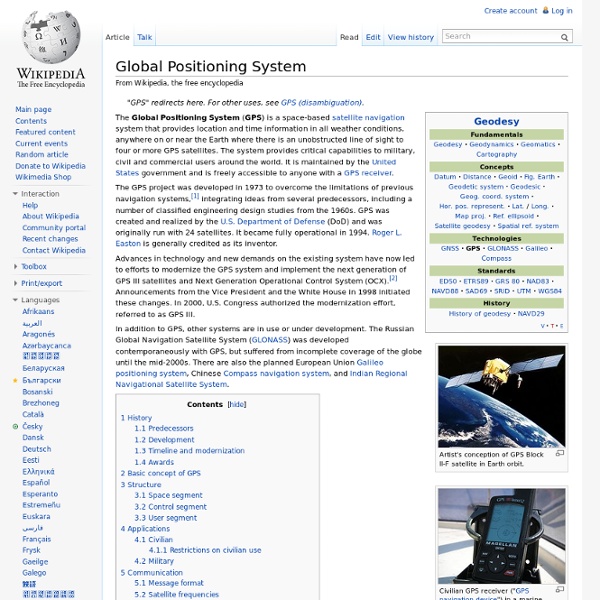Global Positioning System

USNO NAVSTAR Global Positioning System
The following Global Positioning System (GPS) information is obtained from the 1994 Federal Radionavigation Plan (FRP), prepared jointly by the Department of Defense (DoD) and the Department of Transportation (DoT) and other sources such as conferences, meetings and seminars. The GPS is a DoD developed, worldwide, satellite-based radionavigation system that will be the DoD's primary radionavigation system well into the next century. The constellation consists of 24 operational satellites. The U.S. Air Force Space Command (AFSC) formally declared the GPS satellite constellation as having met the requirement for Full Operational Capability (FOC) as of April 27, 1995. Requirements include 24 operational satellites (Block II/IIA) functioning in their assigned orbits and successful testing completed for operational military functionality. GPS provides two levels of service, Standard Positioning Service and the Precise Positioning Service . US Naval Observatory Home Page What Time Is It?
Real Time Kinematic
Overview[edit] Background[edit] Normally, satellite navigation receivers must align signals sent from the satellite to an internally generated version of a pseudorandom binary sequence, also contained in the signal. Since the satellite signal takes time to reach the receiver, the two sequences do not initially coincide; the satellite's copy is delayed in relation to the local copy. By increasingly delaying the local copy, the two copies can eventually be aligned. The correct delay represents the time needed for the signal to reach the receiver, and from this the distance from the satellite can be calculated. The accuracy of the resulting range measurement is essentially a function of the ability of the receiver's electronics to accurately process signals from the satellite. Carrier phase tracking[edit] The difficulty in making an RTK system is properly aligning the signals. Practical considerations[edit] See also[edit] References[edit] External links[edit]
GPS User Support
Civilian User Support — Non-Aviation The U.S. Coast Guard Navigation Center (NAVCEN) is the primary point of contact in the government for providing operational GPS user support to the civilian community. The following links lead to pages on the NAVCEN website. If you suspect a GPS disruption due to illegal signal jamming (Learn more), please call the FCC Jammer Tip Line immediately at 1-855-55-NOJAM, then submit an outage report to NAVCEN. For help with wrong addresses, bad directions, and other map-related errors in GPS devices, please visit our page on Address, Route, & Map Problems. Civilian User Support — Aviation Civil aviation users should contact the Federal Aviation Administration (FAA) for GPS user support within the United States. Military User Support The GPS Operations Center (GPSOC) at Schriever Air Force Base, Colorado, is the focal point in the Department of Defense (DOD) for operational issues and questions concerning military use of GPS. The GPSOC is responsible for:
Finally, A List of Public RTK Base Stations in the U.S. : GPS World
First of all, let me wish a Happy New Year to all my friends around the world and a prosperous 2014. I’m as excited as I’ve ever been about GNSS technology. If I may ask for forgiveness from you if you live outside of the United States, I’d like to start out answering a question I’ve been asked about for several years. The question is: Do you have a list of free sources of RTK base station data in the United States? What is RTK? I’ve tried to keep track of the public RTK bases I know of, so I’ll list them here. Please note that in the following list there are four types of RTK bases: Trimble VRS (network solution).Leica Spider (network solution).Single baseline (eg. I’ve used an RTK rover on all three of these services. To use any of the services, you’ll need Internet connectivity. SIM card inside a data collector.MiFi device.Wi-Fi from a work vehicle. You can also use a commercial RTK Bridge or Repeater such as Intuicom or Base-n-ABox. You’ll also need some sort of NTRIP software utility.
Related:
Related:



